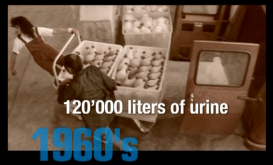What is the relationship between materials and value, and how have they played into scientific practice and authority? This project unravels the long history of the use and value attributed to bodily substances in science and medicine.

Excerpt from a promotional film on fertility drugs produced by the Italian pharmaceutical company Serono, demonstrating the early postmenopausal urine collection campaign. Date unknown. Source: Merck “Corporate History” Archives/Serono Collection, Darmstadt.
Project
(2015-)
